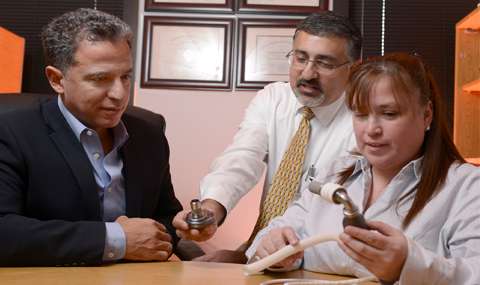Long-term use of ventricular assist devices induces heart muscle regeneration, study finds

Prolonged use of a left ventricular assist device (LVAD) by patients with heart failure may induce regeneration of heart muscle by preventing oxidative damage to a cell-regulator mechanism, UT Southwestern Medical Center investigators have found.
LVADs are mechanical pumps that are sometimes implanted in patients who are awaiting heart transplants. LVADs substitute for the damaged heart by pumping blood throughout the body.
Dr. Hesham Sadek, Assistant Professor of Internal Medicine at UT Southwestern, is senior author of the study, which looked at pre- and post-LVAD samples of heart muscle in 10 patients with heart failure. The study authors examined the paired tissue samples for markers of DNA damage and cell proliferation.
Their study builds on earlier work with mice that demonstrated that newborn mammalian hearts are capable of a strong, regenerative response to injury by activating cell division. The earlier studies further showed that the ability to respond to injury is lost due to changes in circulation that occur after birth, which lead to a more oxygenated environment in the heart, ultimately causing oxidative damage to the cellular machinery that controls heart-muscle regeneration.
In the current study, the investigators reasoned that, by assisting the damaged heart, LVADs would alleviate oxidative damage that occurs within the heart-muscle cells.
"We looked at markers of what is called the DNA damage response in cardiomyocytes (heart-muscle cells) of these patients," said Dr. Sadek. "The response is composed of a cascade of proteins that is activated in response to DNA damage and in turn shuts off the ability of cardiomyocytes to divide. We found that patients who were on LVAD for more than six months had significantly decreased levels of DNA damage response."
Next, the investigators examined the paired tissue samples for markers of cell division. They found that patients who were on LVADs for six months or longer had a significant increase in cardiomyocyte proliferation. The increase in cell proliferation was nearly triple, in fact.
"This result shows that patients with mechanical assist devices have the ability to make their muscle cells divide," said Dr. Sadek. "And the obvious question now is, 'Are these hearts regenerating? Could LVADs be used as a cure for heart failure?' "
Heart failure is a debilitating and deadly disease in which the heart, as a result of injury, cannot pump blood efficiently and hence cannot provide sufficient oxygen to organs throughout the body. About 6 million people in the United States are living with heart failure, according to the American Heart Association, and the incidence is expected to soar over the next 20 years as the population ages and as heart-attack treatments improve and more people survive heart attacks.
Dr. Pradeep Mammen, Associate Professor of Internal Medicine at UT Southwestern, is co-senior author of the study. "Putting in a mechanical pump rests the heart and apparently sends a signal to make new heart cells. This is the first time that this phenomenon has been shown to occur in human heart failure."
Dr. Sadek said the next step is to document that the cell division they observed produces viable heart tissue and a stronger pump.
The Chief of Cardiology at UT Southwestern called the new research "exciting." "Dr. Sadek's findings raise the prospect of reawakening otherwise quiescent cardiac muscle cells, coaxing them into regenerating new and healthy cells. This has been an over-arching objective of the field for many years. The next step will be to leverage these exciting results to rebuild the failing heart," said Dr. Joseph Hill, Professor of Internal Medicine and Molecular Biology.
"This is an exciting advance. We have a long way to go, but hopefully this study will be an important first step toward uncovering methods of promoting myocardial recovery," said Dr. Mark Drazner, Professor of Internal Medicine and Medical Director of the Heart Failure, LVAD, and Cardiology Transplant Program.
Dr. Sadek and Dr. Mammen are members of the newly established Hamon Center for Regenerative Science and Medicine, made possible by a $10 million endowment gift from the Hamon Charitable Foundation. The Center's goal is to understand the basic mechanisms for tissue and organ formation, and then to use the knowledge to regenerate, repair, and replace tissues damaged by aging and injury.
Dr. Eric Olson, Professor of Molecular Biology and Chairman of the Department of Molecular Biology, is the head of the Hamon Center. "This is a fascinating study and a wonderful example of the translation of a discovery in basic science to an important new insight into human disease," said Dr. Olson. "Dr. Sadek's work provides fresh new ideas for stimulating heart regeneration, which is one of the biggest challenges in cardiovascular medicine today."
This study appears online in the Journal of the American College of Cardiology.














